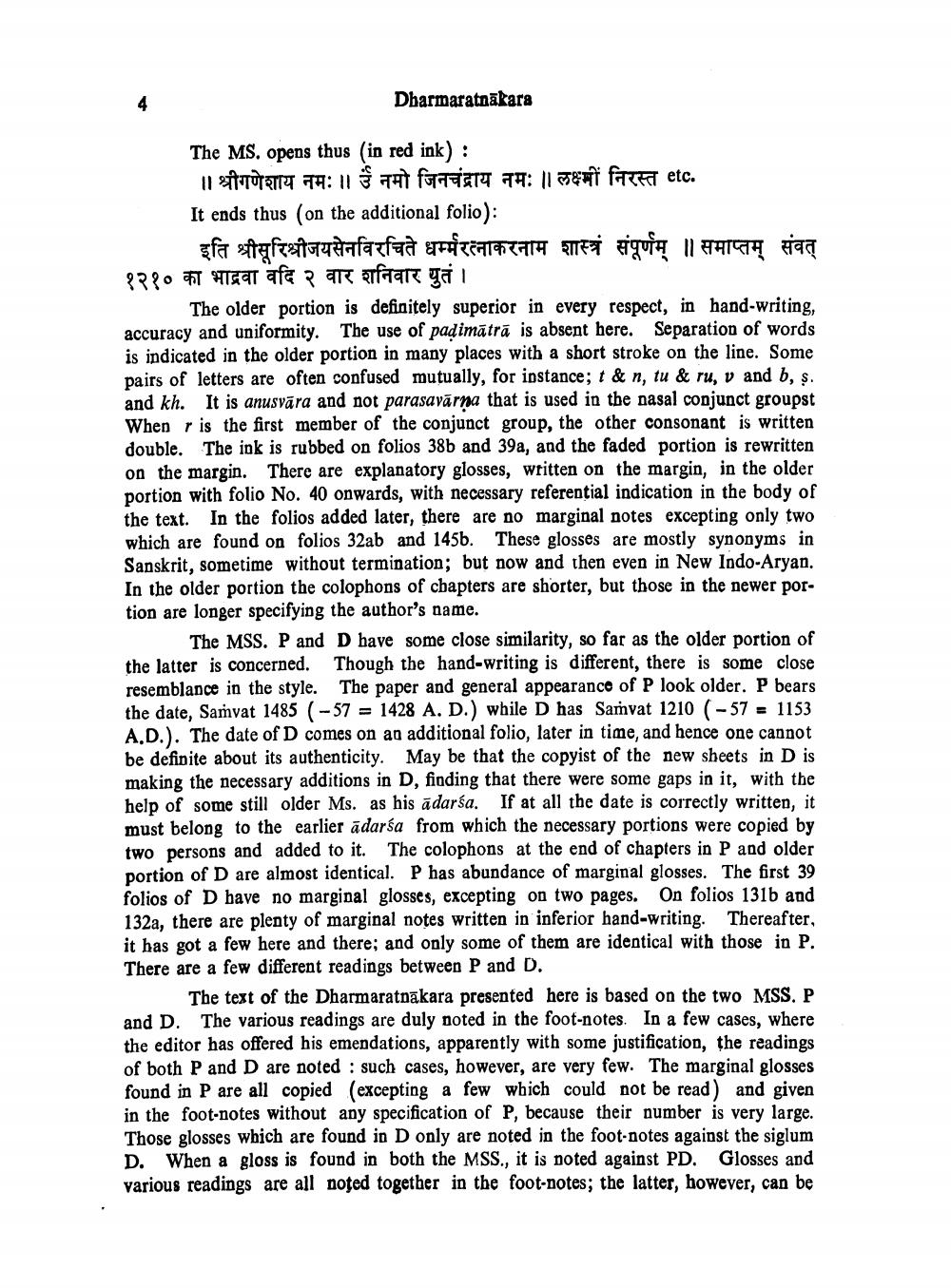________________
Dharmaratnākara
The MS. opens thus (in red ink) :
11 TORTTU 17:11 7 for TU 79: 11 ge* FARCT etc. It ends thus (on the additional folio):
इति श्रीसूरिश्रीजयसेनविरचिते धर्मरत्नाकरनाम शास्त्रं संपूर्णम् ॥ समाप्तम् संवत् १२१० का भाद्रवा वदि २ वार शनिवार युतं ।
The older portion is definitely superior in every respect, in hand-writing, accuracy and uniformity. The use of padimātrā is absent here. Separation of words is indicated in the older portion in many places with a short stroke on the line. Some pairs of letters are often confused mutually, for instance; t & n, tu & ru, v and b, ș. and kh. It is anusvāra and not parasavārna that is used in the nasal conjunct groupst When r is the first member of the conjunct group, the other consonant is written double. The ink is rubbed on folios 38b and 39a, and the faded portion is rewritten on the margin. There are explanatory glosses, written on the margin, in the older portion with folio No. 40 onwards, with necessary referential indication in the body of the text. In the folios added later, there are no marginal notes excepting only two which are found on folios 32ab and 145b. These glosses are mostly synonyms in Sanskrit, sometime without termination; but now and then even in New Indo-Aryan. In the older portion the colophons of chapters are shorter, but those in the newer portion are longer specifying the author's name.
The MSS. P and D have some close similarity, so far as the older portion of the latter is concerned. Though the hand-writing is different, there is some close resemblance in the style. The paper and general appearance of P look older. P bears the date, Samyat 1485 (-57 = 1428 A. D.) while D has Samvat 1210 ( -57 = 1153 A.D.). The date of D comes on an additional folio, later in time, and hence one cannot be definite about its authenticity. May be that the copyist of the new sheets in D is making the necessary additions in D, finding that there were some gaps in it, with the help of some still older Ms. as his ādarśa. If at all the date is correctly written, it must belong to the earlier ādarśa from which the necessary portions were copied by two persons and added to it. The colophons at the end of chapters in P and older portion of D are almost identical. P has abundance of marginal glosses. The first 39 folios of D have no marginal glosses, excepting on two pages. On folios 131b and 132a, there are plenty of marginal notes written in inferior hand-writing. Thereafter, it has got a few here and there; and only some of them are identical with those in P. There are a few different readings between P and D.
The text of the Dharmaratnākara presented here is based on the two MSS. P and D. The various readings are duly noted in the foot-notes. In a few cases, where the editor has offered his emendations, apparently with some justification, the readings of both P and D are noted : such cases, however, are very few. The marginal glosses found in P are all copied (excepting a few which could not be read) and given in the foot-notes without any specification of P, because their number is very large. Those glosses which are found in D only are noted in the foot-notes against the siglum D. When a gloss is found in both the MSS., it is noted against PD. Glosses and various readings are all noted together in the foot-notes; the latter, however, can be




